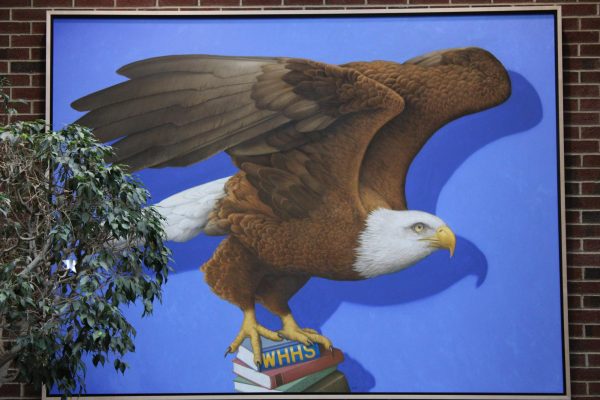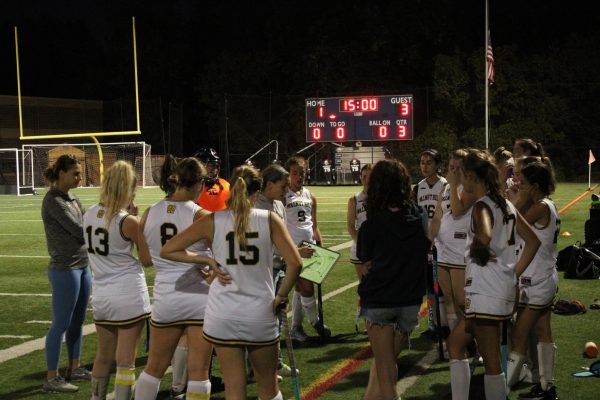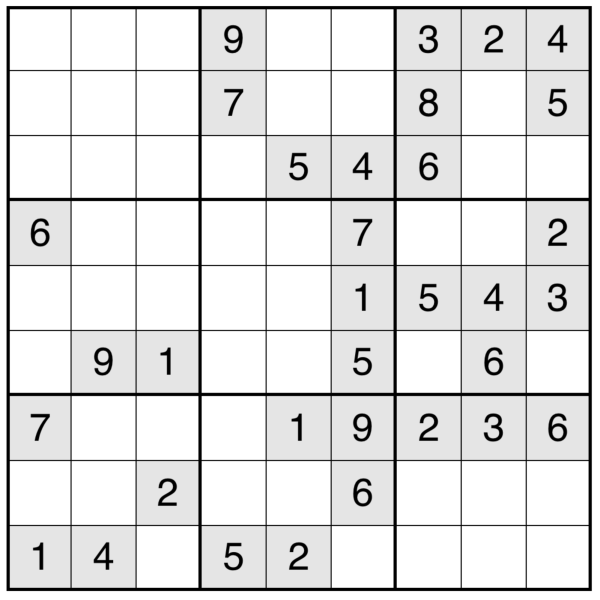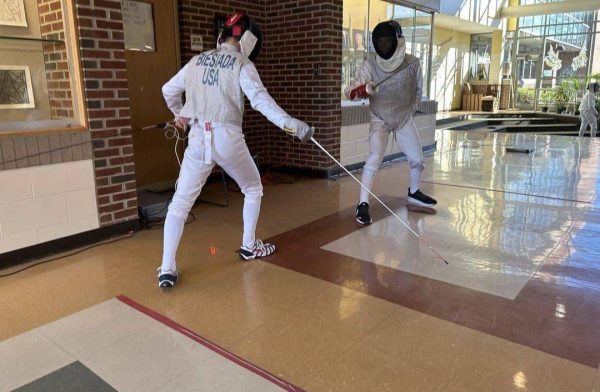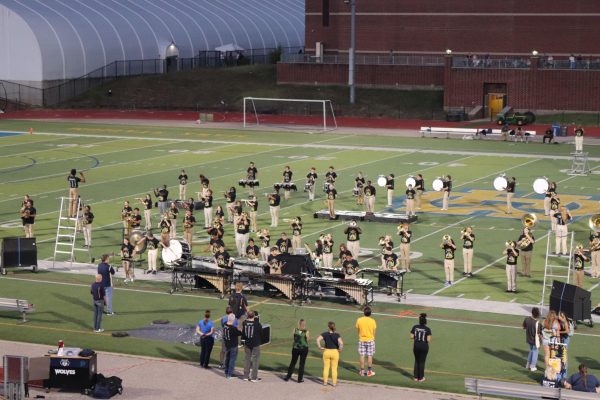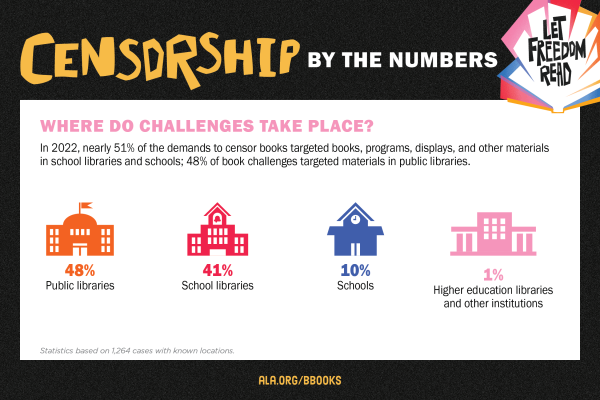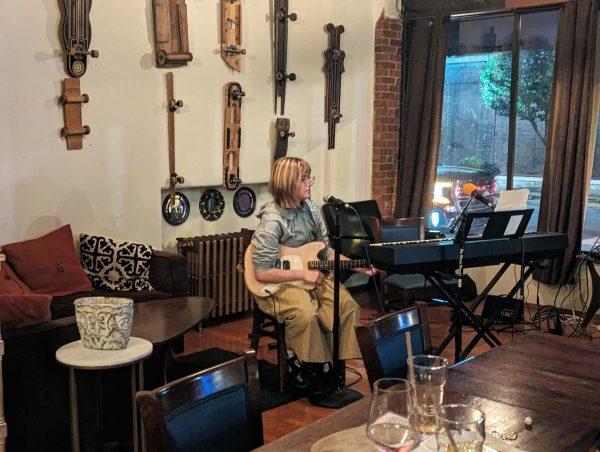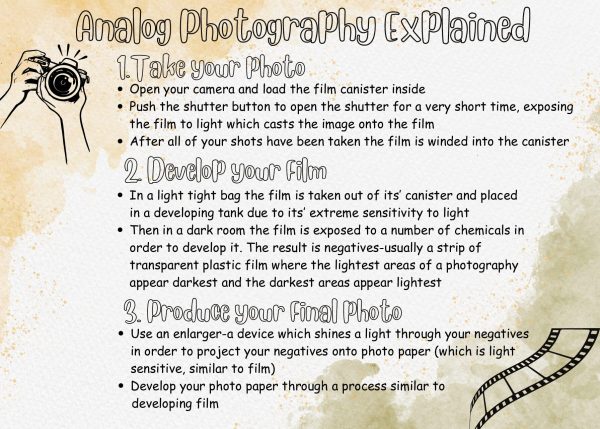WHHS art course guide
WHHS prioritizes student creativity and expression with its art courses. Walnut’s many classes might be a bit overwhelming to choose from but hopefully this crash course will help some indecisive, art oriented kids. Or kids who just need some art credits.
Jr. Art: Foundations
- Introductions, mixed media, two and three dimensional design are all part of this class to introduce students to the world of art. Art history and appreciation, individualized pursuit of interest, are all used as an introduction to Walnut Hills art classes and what teachers will be preparing students to do in future art classes.
- Grades 7 and 8
- 1 Semester
- $30 fee
Jr. Art Student Questions
What’s your name and how do you spell it? Preferred pronouns?
Grey, any neo pronouns.
What grade are you in?
8th.
What grade were you in when you took this class?
7th
Do you think this class prepared you for future art classes?
Yeah it goes over everything.
What does Jr. Art teach?
It goes over different types of mediums.
What was your favorite project?
Making and carving clay.
What type of projects did you do?
Usually physical creation.
How do you feel about this class?
I enjoyed it
What did you learn from this class?
I learned how to glaze.
What was your favorite part of this class?
Building a snowman.
What’s some constructive criticism that you would give to make this class better?
I think for peer criticism there shouldn’t be a set amount of criticism. I like to compliment instead of criticize.
Is there anything you’d like to add?
No not really, I enjoyed the class.
Pro Media Design
- Focused on applying design elements to artwork. Utilizes different mediums and techniques for future problem solving, environmental design, fine arts, crafts and 3-dimensional artwork. Influence of other artists and designers are included.
- This course is a vital bridge between junior art and advanced art classes such as AP art.
- Grades 8 and 9
- Required art classes before this is Junior Art
- Credits: 0.5 unit, 1 Semester, Fine Art Credit
- $35 fee
Pro-Media Design Student Questions (Luke Morgan)
What’s your name and how do you spell it? Preferred Pronouns?
Luke Morgan, they/he.
What grade are you in?
9th.
When did you take pro-media?
First semester this year.
What made you want to take pro-media?
It was one of the prerequisite art classes and it was one of the ones available.
What was your favorite thing that you learned?
Color theory, and I thought that was cool, and we made sculptures with books.
Rate the class’s difficulty
It wasn’t very difficult, 3/10.
What is the workload like?
It was kind of medium, not too much.
How do you feel about the environment?
I liked it but it was kind of messy at times and it wasn’t always crystal clear what we should be doing.
What was your favorite project?
The carving one in the books.
Did you like pro-media?
Yeah I didn’t like it that much, I thought a lot of the projects felt a bit childish and the teacher wasn’t always clear with directions.
Do you have to spend any money on supplies?
$15.
Is there anything you’d like to add?
No.
Art XX: Drawing and Painting
- Focusses on composition and design with the elements used in drawing and painting. Utilizes transitional techniques, shading techniques and figure sketching in various media. Painting broadens on watercolor and acrylics.
- Grades 9, 10, 11, 12
- Required previous art classes: Art 7, 8, or 9
- Credits: 0.5 unit, 1 semester, fine art credit
- $30 fee
Art XX Teacher Questions (Watling)
What’s your name and how do you spell it? What are your preferred pronouns?
Kim Watling, she/her.
What art classes do you teach?
Art 1, Art 2, and Art XX.
Why do you like teaching Art XX?
Because a lot of the students haven’t had much drawing or painting experience, so i tell them that if they know how to read they know how to draw. I like to see students get excited about the skillset and the confidence that comes with doing the activities as the year goes on.
What do you think students need to have learned by the end of the semester?
I focus on drawing from observation, and creative drawing from memory, facial proportions, and drawing portraits. Basically, figure drawing, and color theory in painting.
What effect do you hope to have on your students?
I hope that they experience my art class as a creative and safe place to be. I look at art more as therapy so it’s a class they can use to express themselves freely and grow. I think it’s a good break from the academic aspect.
What is special about Art XX as an art course?
It concentrated more on drawing and painting which are fundamental skills that you can apply to any other course. And exploring self expression as far as portraits of other people is a special part of that class.
What does Art XX prepare students for in regards to their future?
Drawing skills mostly and portraits and landscapes are two things that they’ll use and do in other classes. Understanding foreground, middle ground and background and human proportions will most likely be used in other courses too.
And lastly, what students would you recommend this class for?
A lot of students that have not taken any art and they’re not ready for two semesters of art so I think it’s a good next step from learning basic Jr. Art skills, to enhance your drawing skills and understanding color theory. So I recommend students from Jr. Art. I think it’s a good course for someone who has yet to experience art in highschool, and for students considering going into more advanced art.
Is there anything you’d like to add?
No.
Art XXX: Sculpture
- Focuses on three dimensional art, emphasis on mass, volume, space and surface media. Media such as paper, foil, clay, wood, glass, plaster, plastic and “found objects” will be mainly utilized in this class. Includes basic ideas of additive and subtractive procedures in assembly, casting, and modeling. This course also orbits art history, art appreciation, art criticism, art aesthetics, as well as studio experience.
- Grades 9, 10, 11, 12
- Required previous art courses: Art 7, 8, or 9
- Credits: 0.5 unit, 1 semester, fine art credit
- $30 fee
Digital Imaging
- A semester art course that introduces the world of digital photography and design. Students will need prior knowledge from courses like Jr. Art. This course focuses on learning the basics of Adobe Illustrator, and Adobe Photoshop to create vector and raster images. Digital Art is always evolving and this course will open students up to this modern way of art expression. Digital Multimedia is the suggested course to take after this.
- Flash drive is required for this course to store digital work.
- Grades 9, 10, 11, 12
- Requires teacher approval
- Credits: 0.5 unit, 1 semester, fine art credit
- $30 fee
- (Interview questions about this course can be found under the Digital Multimedia information.)
Digital Multimedia
- Expands upon Digital Imaging and goes deeper into Adobe Photoshop and Adobe Illustrator. This will expand on skills and concepts such as 3-D Imaging, animation GIF design and 3D Printing. Digital Imaging is a prerequisite for Digital Multimedia.
- Flash drive is required for this course to store digital work.
- Grades 9, 10, 11, 12
- Requires Digital Imaging and teacher approval
- Credits: 0.5 unit or 1.0, 1 semester or 2 semester, fine art credit
- $30 fee
Digital Imaging/Multimedia Art Teacher Questions (Cucchetti)
What’s your name and how do you spell it? Preferred pronouns?
Cucchetti, he/him
What do students learn in this class?
It’s like any other art class, we do traditional aesthetics but instead of doing traditional art we make art with computer software and apps like that, working in the digital age.
What other courses are recommended for students after they take this class?
If you enjoy the first semester then you follow up with digital multimedia and then take an AP course with a focus on digital media.
What is the significance of this digital art class? Why is it important?
I think we interact with digital images like everyday and they’ve been curated by someone and all of that comes with visuals and being able to provide and navigate that, not all of that is of equal caliber so this kind of gives kids a sampling of what it looks like and how it can be used.
Describe the workload.
It’s a studio based course and the kids pretty much work everyday. Each project takes about 9 – 10 class periods. There isn’t homework but kids might have to take photos to bring into their classroom.
What’s the most important thing students should take away from this class?
I think I work really hard at acknowledging the fact that 90% of my students aren’t taking my classes because they want to do a career in the field. There are a very wide range of reasons why people are here. I try to give kids a lot of skill tools that go beyond art. It’s more about actual life and getting a better feel of digital art and mediums.
And lastly, what prior courses do you suggest students take before this class?
Jr. Art, but sometimes there are exceptions so I do spend a few weeks at the beginning to review past skill sets that students may not have.
Is there anything you’d like to add?
This is a very popular class and people get rejected a lot so if you do take this class, take advantage of it.
Art 1: Beginning Art
- Intermediate studio course for students looking to refine their artistic skills. This includes drawing, painting, design, printmaking and sculpture (all learned about in previous art courses). Students will be taught advanced artistic techniques and will use professional artist materials while learning. Students will get studio experience along with expansion of art concepts and techniques in a professional environment. Students will also learn through studying art historical themes and art critical dialogue.
- Grades 9, 10, 11, 12
- Requires teacher approval or Jr. Art 7, 8, 9
- 1.0 unit, 2 semesters, Fine Art Credit
- $60
Art 1 Teacher Interview Questions (Watling)
What’s your name and how do you spell it? Preferred pronouns?
Kim Watling, she/her.
What made you want to teach Art 1?
It was pretty much given to me. I love it now that I know what it is. I like it because it encompasses a lot of mediums like printmaking, painting, drawing and glasswork.
What does Art 1 prepare students for?
Art 1 prepares students to decide what medium they prefer, whether it be 2-D or 3-D because they get to try different mediums so early, they get time to figure it out.
How would you describe deadlines in this class?
The deadlines have changed because of covid and remote learning, they’ve become more flexible. I’ve adapted the deadlines according to students or environmental changes.
What is this course meant to teach?
Art 1 is meant to enhance their understanding of elements and principles of art and to be able engage in art criticism and discussion and understanding their own art and others art. Or other artists that we study and also finding a medium that they prefer to work with.
What is the significance of this course? Why is it an important course to take?
It gives students a variety of things to work on and it’s important for them not to have an artistic daily routine. I like to introduce different things. Problem solving is important.
What kids generally take this course?
Usually kids who are more involved in art because it’s a 2 semester course so they have to be committed to a full year. It’s rare for students to take this for just art credits.
What do students tend to struggle with in this class?
Confidence in their own skills and that’s why they should take it. And comparing their work to others, I encourage them to learn from others’ work instead of comparing. Motivation seems to have changed and become less of students getting excited about something, I think that’s a struggle.
How is a two semester art course different from a one semester course?
I create projects that take longer like printmaking which is a very involved process so the projects. And in Art 1 I create projects that involve more like doing research, sketch, and paint. They’re usually integrated into other courses like math and science.
And lastly, what students would you recommend this course for?
Students that want to go on to AP art or have some art related career or job that they could use in their careers. I think it’s just students who are more serious about art or students that love art but don’t have that much experience.
Is there anything you’d like to add?
No.
Art 2: Intermediate Art
- This class is more labor intensive and requires reflection and work out of class to really advance in one’s art skills. This course focuses on time management and self discovery and prepares students for hard deadlines. This class can be a very important asset to those intending to take an advanced placement program in the future. In addition to drawing and painting, exploration with sculpture, ceramics, textiles and printmaking will also be broadened. A successful studio art student should end the course with deep knowledge of their strengths and an idea of what direction they may take to further their art education.
- Grades 10, 11, 12
- Requires Studio Art 1 or Beginning Design Studio and teacher approval
- Credits: 1.0 unit, 2 semesters, Fine art credit
- $60 fee
2D – Design Studio
- Design Studio revolves around creative problem solving in architecture, graphic design, fashion design, environmental design and community planning. There are also interior, industrial and advertising design elements taught in this class as well. Students will be expected to employ previously learned art concepts to create two and three dimensional images that will be used as functioning objects. This course includes a wide variety of design processes such as illustration, bookbinding, package design, toy design, jewelry making, and model building.
- Grades 9, 10, 11, 12
- Requires teacher approval and Jr. Art 7, 8 or 9
- Credits: 1.0 unit, 2 semesters, fine art credit
- $60 fee
2D Design Teacher Questions (Cucchetti)
What’s your name and how do you spell it? Preferred pronouns?
Cucchetti, he/him.
What does 2D design teach?
2D design is a year long foundational course. If you want to go into an art career then this course is highly recommended before taking AP art courses. I get more flexible with the students as the year goes on and give the kids more creative freedom. First quarter is very basic stuff and the second quarter is graphic design and I try to bridge with professionals. We’re talking to another company to work with the kids to redo the corporate identity of walnut so the class is going to work directly with the design firm.
Why did you want to teach this class?
I have been teaching since ‘98 and I’ve taught in multiple districts. I had some experience with digital imaging and when I got to walnut these we’re the classes that needed to be taught. I’ve just kind of molded the classes to fit me more. I will teach anything the district wants me to teach, I’m here for the students.
Describe the expectations of the class
Not too much different, I don’t expect anyone to be good at art to take art. People tend to think you need talent to take art courses and I don’t believe in that. Art’s like a language and once you understand how to translate it, you can influence that conversation with your art piece. I work hard at putting in the support for students who have a high level of success. I would not say my classes are an easy A but I want the kids to have that level of mastery to get that easy A. It’s important to me to find what they want to do and how they want to do it.
Is there anything kids need to know before optioning for this course?
They should know there’s a fee attached to it and the fee offsets the cost of the classes but I don’t want the fee to weigh whether or not the kids take the class. If kids have a problem with the fees, they should come talk to me. We don’t have parties or study halls, those just don’t exist. But I do give ample time to do their projects because I understand the beast that walnut is. I like for students to be able to design the class for what they want to do. And having a portfolio that reflects what you want to do in the work field is super important.
And lastly, what students would you recommend this class to?
All of the students, anybody who has any desire to take it.
Is there anything you’d like to add?
No.
Photography 1
- This course is designed to teach the fundamentals of photography, research and experimentation as key factors. Students will write evaluations and make cognitive reports about their experience with photography. This course will go over development, exposure, and photo printmaking, as these are all important parts of the photography process. All materials and camera equipment must be purchased and supplied by the student. Independent field trips and projects covering an extensive time period are necessary components of the course.
- This course does not satisfy the junior high art requirement
- Grades 9, 10, 11, 12
- Requires teacher approval
- Credits: 0.5 unit, 1 semester, fine art credit
- $35 fee
Photography Student Questions (Grimm Savu)
What’s your name and how do you spell it? What are your preferred pronouns?
Grimm Savu, they/them
What grade are you in?
9th
When did you take photography? For how long?
This year for one semester
What made you want to take Photography?
I’d say the interest in overall capturing natural nature and capturing beauty in what you see.
Did you like Photography?
I did.
What projects did you do?
Created our own camera from a box, took a lot of photos, and used a lot of dark room chemicals.
How do you feel about the environment?
It’s very nice, there’s a light workload and the teacher’s friendly.
How much do you think you spent on supplies?
I think I spent about 40 dollars, all I had to buy was film and photo paper since I already had a camera
And how much do you think the required camera costs?
The camera costs $60, but it would be cheaper from a thrift shop. You can also borrow a camera from the teacher.
Did you enjoy this class?
Yeah I did, some of it was kinda dreary because of the slideshow projects, but there is a lot of talking to people around you.
What’s the workload like?
The slideshows took about a day to complete. The end exam took a while which was just gathering photos that you like and showing them. I don’t really see taking photos as work so it’s pretty light.
Rate the difficulty of this class.
I would say it’s a 0, the only difficult aspect is actually getting yourself to take photos.
What was your favorite thing you learned?
All the stuff about pin-hole cameras.
What do you think this class prepared you for in the future?
I’d say it helped me learn about how dangerous chemicals can be.
Do you think the academic part of this class is fulfilling?
Yes it was worth it, the starting few weeks isn’t great but the rest of the class is fine. The teacher talks a lot and there’s not much action going on and there’s a slideshow project, but overall there’s not much action until you get to take photos.
What is the hardest part of this class?
The end presentation and a test that’s memorizing parts of the cameras and I’d say that’s fairly hard.
Would you recommend this class?
Yes.
Is there anything you’d like to add?
The class does take a bit of patience with the teacher and if you can’t sit through 10 minutes of talking it can get kind of annoying.
AP Studio Art: Drawing
- This course prepares students for College Board evaluation and Advanced Placement Credit requirements. The 2D Design Portfolio requires students to demonstrate the mastery of 2D design elements and principles through any two dimensional medium or process. This includes graphic design, digital imaging, photography, collage, fabric design, weaving, illustration, painting, and printmaking. This class is high-paced and taught and assisted by highly qualified instructors and artists. Students are expected to create a body of work based on a college level curriculum. Students may be required to purchase special equipment to use for their portfolio projects. There is a charge for the AP exam. There is a summer component of specific works of art, which are assigned by an instructor in the spring of the preceding year. The completion of this summer project is crucial to the success of the student in Studio AP 2D Design. Completing the AP exam requirements are mandatory. At completion of this course students should have a portfolio of 25 to 30 completed works of art created at a college level.
- Grades 11, 12
- Requires Art 1 & 2, 2-D Design and Teacher Approval
- Credits: 1.0 unit (weighted course), 2 semesters, Fine Art Credit
- $100 fee
AP Studio Art: 3-D Design
- Much like AP Studio Art: Drawing, this course prepares students to meet requirements for the college Board Evaluation for Advanced Placement credit. To make the portfolio required for this class, students are asked to demonstrate mastery of 3D design through any three-dimensional approach. This includes figurative or non figurative sculpture, architectural models, metalwork, ceramics, and three dimensional fiber arts. Students will be working with highly qualified instructors and artists at a college level. They will be working with sculpture media and techniques. Students may need to purchase specialized materials for portfolio projects.There is a charge for the AP exam. There is a summer component of specific works of art, which are assigned by an instructor in the spring of the preceding year. The completion of this summer project is crucial to the success of the student in Studio AP 3D Design. Completing the AP exam requirements are mandatory. At completion of this course students should have a portfolio of 16 to 20 completed works of art created at a college level.
- Grades 11, 12
- Requires 2-D Design Studio, Sculpture and Teacher Approval
- Credits: 1.0 unit (weighted course), 2 semesters
- $100 fee
Your donation will support the student journalists of Walnut Hills High School. Your contribution will allow us to purchase equipment, cover our annual website hosting, printing costs and offset competition and conferences fees for students.
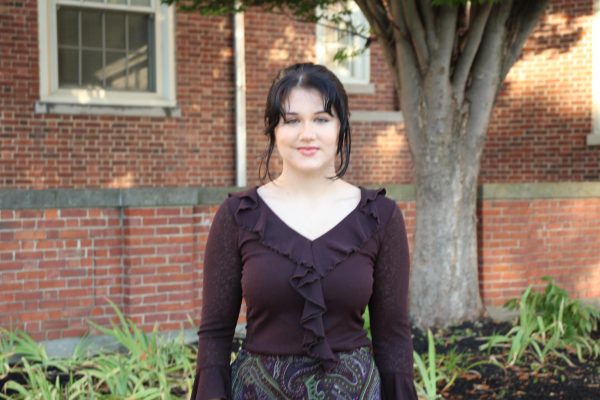
In their third year as a Chatterbox staff member, Corey Wasem is excited to work as a Broadcast staff member. They hope to create fun and impactful projects...
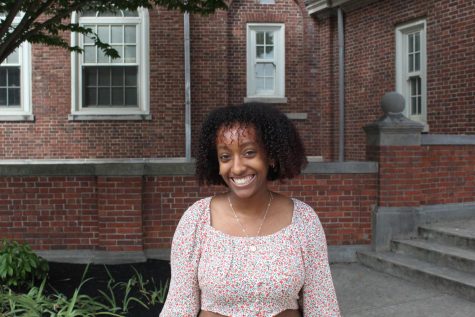
In her second year as a Chatterbox staff member, Nazret Degaulle is eager to work as the managing editor of student life. This year, she is excited to...



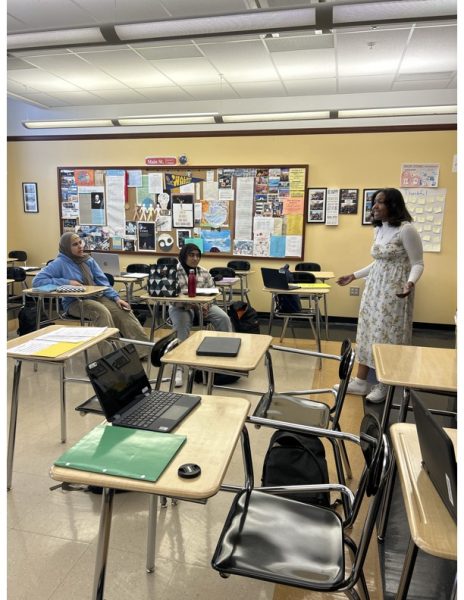

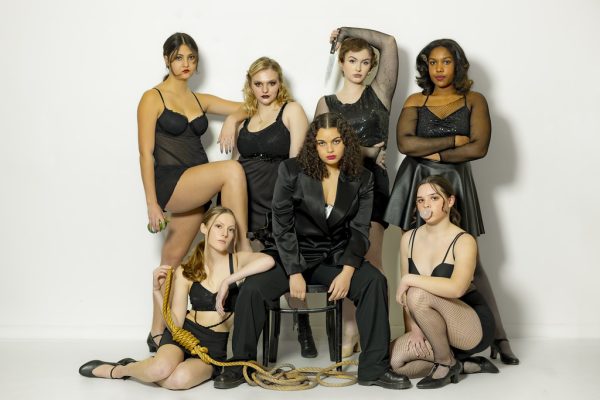
![Film Club meets every Friday in Mr. McCormicks room (1602) from 3:15 to 4:15 to watch and analyze films and connect with other students with similar interests. “My favorite part is just looking over at my friends [when] something crazy happens on screen and [being] kind of like “wait [what]’ and when people start yelling at the movie,” Faith Wallace, ‘24, said.](https://whhscbox.com/wp-content/uploads/2024/02/IMG_9711-600x400.jpg)
